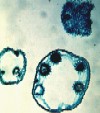- Appearance: non-flagellated unicells, flagellates, filaments, colonies, coenobia, sarcinoid cell aggregations, siphonous forms
- Cell division always involves closed mitosis and a phycoplast (microtubuli parallel to the division plane)
- Plasmodesmata are present in species that build cell wall by Golgi vesicle depositions but are lacking in species that divide by furrowing
- Sexual reproduction by isogamy, anisogamy, or oogamy result in thick-walled, spined hypnozygotes (zygospores); zygotes serve as „resting spores“ and germinate by meiosis
- Asexual reproduction by
- Zoospores: flagellates with eye-spot and contractile vacuole
- Aplanospores: non-flagellated cells with contractile vacuole
- Autospores: non-flagellated cells lacking contractile vacuole
- Terrestrial species predominantly form autospores (no liquid medium)
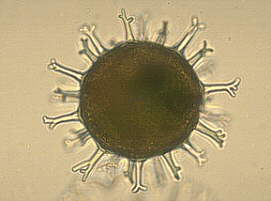
- Monphyletic group of chlorophyceans
- Mostly non-flagellated species but flagellates spores and gametes
- Ankistrodesmus produces 1-16 autospores per cell
- Pediastrum is a very common freshwater colony with species-specific number of cells; exhibits autocolony formation: each cell can divide into the same number of zoospores as the number in the colony; zoospores are retained within a vesicle and arrange in the same planar pattern as the mother colony; young colonies are released from the vesicle
- Hydrodictyon, the „water net“, 4-6 cm wide; single cells of up to 1 cm, multinucleate; autocolony formation by ca. 20,000 bi-flagellate zoo-spores within mother cell; isogamous sexual reproduction
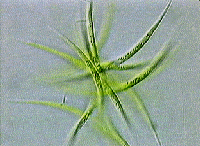
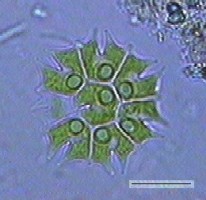
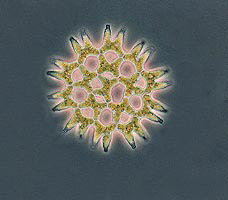
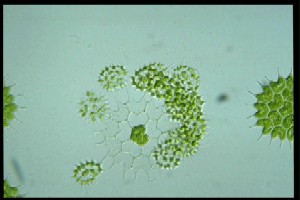


- Chlamydomonas: biflagellate unicell with cuplike chloroplast, very common; 500 species in the genus
- Major model system for genetic and physiological research
- Asexual reproduction by 2-16 mitotic cells
- Sexual reproduction by isogamous or anisogamous biflagellate gametes; some oogamous species;

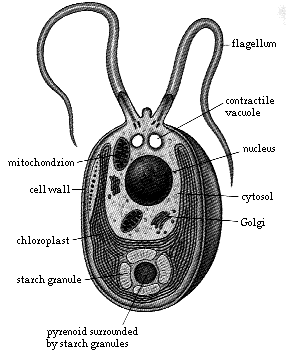
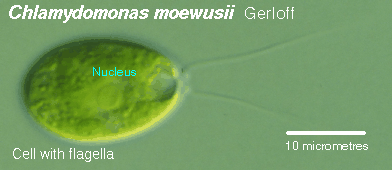
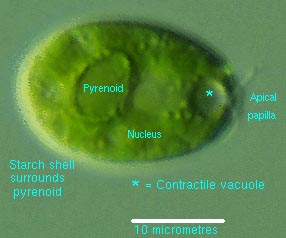
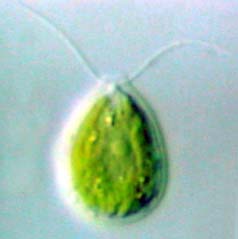
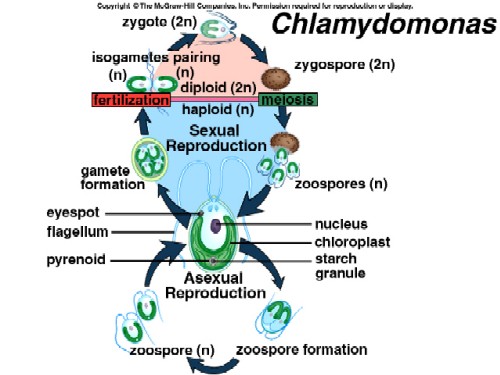
- Monophyletic group of coordinated colonies of multiple of two Chlamydomonas-like cells
- Mucilagenous matrix or cells hold loosely by mucilages in one layer, forming a hollow sphere in more evolved species
- Large colonies seen as predator defense
- Common forms in summer freshwater systems
- Increase in complexity from the genus Gonium to Volvox:
- Gonium: 4, 8, or 32 cells in flat plate
- Pandorina: globular colony of 16-32 biflagellate cells that are closely adherent at their bases; eye-spots in anterior cells larger than in posterior cells, first degree of colony polarity
- Eudorina: globular colony of 16-32 firmly connected biflagellate cells;
- Volvox: large (500 to several thousand cells) colony, cells in a peripheral mucilage shell; each cell possesses its own mucilage package; protoplasmic strands connect cells; anterior eye-spots larger, reproduction from posterior cells
- Flagella origin: whereas V-shaped in Chlamydomonas, the flagella originate parallel in the Volvocales
- Flagella beat in the same direction (in opposite directions in Chlamydomonas) and flagella beat is coordinated among cells of the coenobium
- Positive phototaxis is common among Volvocales
- Eye-spots are mostly larger in apical cells
- Swimming path: colonies rotate in flat coenobia (Gonium) and „roll“ through the water in spherical coenobia (Pandorina, Eudorina, Volvox)
- Interconnection of cells is more complex in more complex coenobia (from Gonium to Volvox)
- Autocolony formation: gonidia develop by asymmetric cell divison in the posterior part; at 8-cell stage, a pore opens; when final cell number is reached, colony inverts through pore
- Sexual reproduction starts by some colonies to produce male gametes (flat packets of 16-64 pale flagellates); they release a pheromone that triggers female gamete (egg) production;
- Fertilization: sperms lyze whole in female colony and fertilize eggs; unfertilized eggs may produce colony
- Zygote develops thick, red, spiny cell wall
 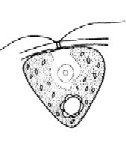 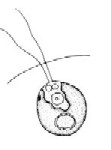
Single flagellates in (from left to right): Gonium, Pandorina, Eudorina, Volvox 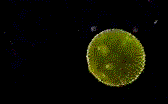 
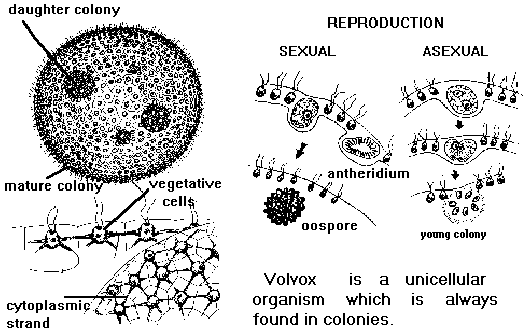

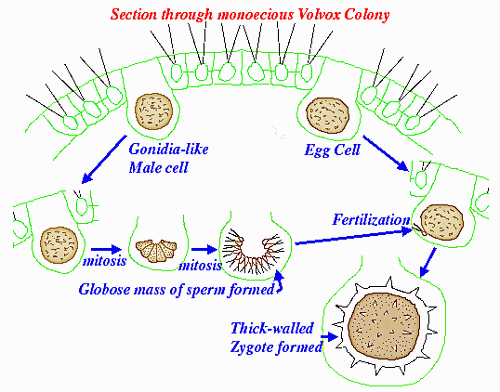
|

|
- Formerly assigned to the class Tetrasporales
- Large gelatinous coenobia predominantly in the epiphyton
- Pseudocilia: each cell carries two pseudocilia instead of flagella; pseudocilia lack the two central microtubuli of the typical 9+2 structure and developed by reduction of flagella
- Reproduction by colony fragmentation, zoospores, and isogamy
- Flagella origin: whereas V-shaped in Chlamydomonas, the flagella originate parallel in the Volvocales
- Flagella beat in the same direction (in opposite directions in Chlamydomonas) and flagella beat is coordinated among cells of the coenobium
- Positive phototaxis is common among Volvocales
- Eye-spots are mostly larger in apical cells
- Swimming path: colonies rotate in flat coenobia (Gonium) and „roll“ through the water in spherical coenobia (Pandorina, Eudorina, Volvox)
- Interconnection of cells is more complex in more complex coenobia (from Gonium to Volvox)

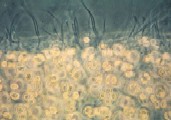
- Dunaliella clade: named after Dunaliella, group of flagellates, non-motile unicells, filaments; temporarily grouped by genetic sequence results
-
Chaetophorales:
branched or unbranched filaments with quadriflagellate
reproductive cells

from left to right: Uronema, Microspora, Chaetophora, Draparnaldia, Fritschiella

from left to right: Haematococcus, Dictyosphaerium, Selenastrum, Botryococcus, Dunaliella
- Small group (3 genera, 600 species) of freshwater, filamentous algae with uninucleate cells
- Characteristic genus: Oedogonium
- Chloroplasts are highly dissected, net-like
- Sexual reproduction by oogamy
- Ring of flagella on zoospores and male gametes
- Dwarf male thallus lives on female thallus
- Cell wall of Oedogonium possesses characteristic „rings“ near the apical end due to intercalary cell division

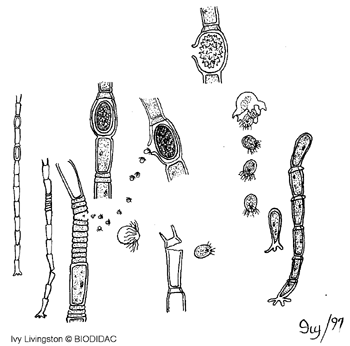 |
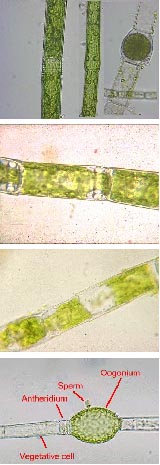
Upper: vegetative cells and zygote of Oedogonium; middle: rings on cell wall of Oedogonium; lower: fertilization of egg cell by sperm (oogamy) in Oedogonium The Oedogoniales species Bulbochaete carries long, thin spines at the apical end of the branches |







